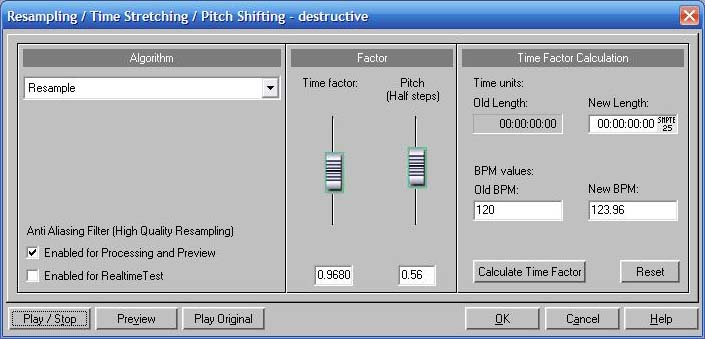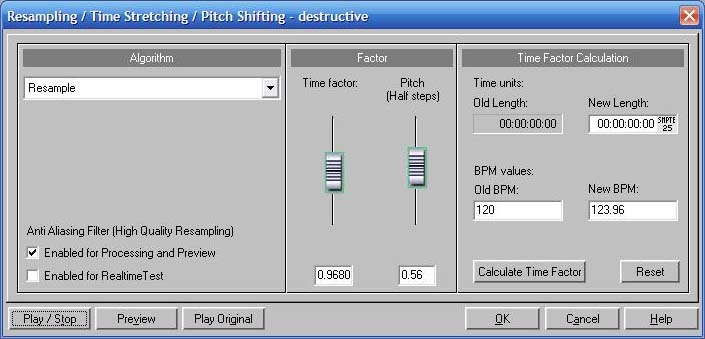View Post [edit]
| Poster: | Headphone | Date: | May 31, 2011 10:42pm |
| Forum: | GratefulDead | Subject: | Tech: Pitch correction |
Reply [edit]
| Poster: | dead-head_Monte | Date: | Jun 1, 2011 8:08pm |
| Forum: | GratefulDead | Subject: | Re: Tech: Pitch correction |
Pitch Correction & Speed Correction • CM has done numerous pitch correction upgrades recently based upon the pitch & speed error information supplied by Joe B. Jones. Apparently, Joe has perfect pitch. Perfect pitch analysis is the best way to go to get your error parameters defined accurately. There are numerous Audio s/w products being used to correct Pitch and/or Tape Speed errors on recordings. You can correct the Pitch only, the Speed only, or both Pitch and Speed (Resample Mode). It is imperative to understand this. I have some limited experience and knowledge to share with you. Listed below are some "ptich correction" conversations you can read and learn from. • Phil Lesh on trumpet playing Jazz tapes - my pitch & dehiss upgrade for Phil's 70th birthday • Are these tapes in tune? • audio restoration software discussion
pitch correction module in Samplitude Pro s/w
This post was modified by dead-head_Monte on 2011-06-02 03:08:56
Reply [edit]
| Poster: | Headphone | Date: | Jun 1, 2011 10:26am |
| Forum: | GratefulDead | Subject: | Re: Tech: Pitch correction |
Reply [edit]
| Poster: | dead-head_Monte | Date: | Jun 2, 2011 11:40am |
| Forum: | GratefulDead | Subject: | Re: Tech: Pitch correction thesis |
Computer Animation Models vs Pitch Correction Models
— Animation Fairings and Pitch-correction Algorithms —
Fairings, also known as ease-ins /outs, slow ins / outs... whatever you want to call them, are what you need in your audio Restoration software! Fairings are about interpolation - or in plain English, how you either accelerate or decelerate from one key frame of animation (or segment of Audio) to the next. Take a simple example of animation: suppose we want to animate a scene in which a car begins a journey. First the car is at rest, then a few seconds later it will be up to speed. But it does not go instantly from one state to another; it will accelerate from being static to its cruising speed. This acceleration is one kind of fairing. The ink and paint program Animo deals with fairings very comprehensively. The author of the "Animation Fairing doc" I linked to has grabbed these screen shots from it to illustrate things. Here is how you represent a linear move between two key frames in Animo and it shows a case where there are no fairings:
The starting frame is at the bottom left and the end frame (in this case, frame 16) is at the top right. As you move across the graph from left to right, you are progressing in time. As you move up the graph, you are altering a value. This value will very often be the distance of a movement, but it can just as easily be a change in a quality such as color or degree of blur and so on. In your case, it's tape speed error and the resulting pitch error. By the way, if the line of the graph were horizontal, this value would be the same and this would then in effect be the same as a hold. A linear move, as is obvious from the graph above, means that for every frame, every in-between change is the same amount. This means that each frame (the "fence" at the bottom) is equidistant from its neighbor. Many movements start slowly, get up to speed, then end slowly (for example, if a character turns their head, the move might well start and end with fairings like this:)
On the other hand, many movements may accelerate from scratch but end suddenly without a fairing. For example, suppose you are animating a hammer hitting a nail. The hammer will move by accelerating until the point at which it hits and it stops dead. For this very common sort of move, you want a curve like this:
The opposite would be a move that only slows. (Say a marble rolls to a halt; it will decelerate throughout the move):
Note two things about these graphs: first, each control point has a handle with which the animator can "finesse" the move to their heart's content by adjusting the slope of the curve. Second, though not shown here, it is also possible in Animo to add as many extra control points as you want to make very much more complex movements such as oscillations. The examples above are just basic curves. By altering these curves carefully, a piece of average animation can be given the extra sparkle and flair that makes it special. For instance, by changing the direction of a fairing's curve, you can create an "overshoot" in the animation. Learning how to tweak these fairings is the mark of a good animator. Fairings are always used by character animators who are professional. Basically, we have three types of motion: slow-fast-slow; fast-slow-fast; and linear (steady drip, drip, drip...). Animation motion sequences also include halts or pauses (periods of no motion). In the meantime, you can manually correct your tapes like this. Use a "least common denominator" guestimation method. Try this. Find the longest segments (keyframes) of tape material you can keep correcting perfectly using s/w interpolation - without over-shooting or under-shooting the Resampling methods you try using. Check the playback for each experiment you run. Does it sound correct yet? Are these keyframe segments about 10 minutes long, 5 minutes long, or about 1 minute long? |
• Monte Barry has worked with numerous computer animation systems as a video engineer
- video engineer for Computer Image Productions, Denver, CO, 1984 to 1986
Scanimate computer animation system used analog video processing
designed and built by Computer Image Corporation in Denver
- see the Scanimate alumni web page
- watch their Dream Machine movie trailer on YouTube - 01:38 length
• 20 years ago, I was running Autodesk's 3D Studio animation s/w on my PC
"News Update" smoke and mirrors demo image by Monte in 1991
designed and rendered on my PC in 3D Studio ver 2.0 DOS
• Monte's Taper Handbook
This post was modified by dead-head_Monte on 2011-06-02 18:40:13
Reply [edit]
| Poster: | Headphone | Date: | Jun 1, 2011 7:40pm |
| Forum: | GratefulDead | Subject: | Re: Tech: Pitch correction thesis |
Reply [edit]
| Poster: | dead-head_Monte | Date: | Jun 2, 2011 9:51am |
| Forum: | GratefulDead | Subject: | Re: Tech: "Flying Faders" same thing as "Flying Reels" |
 This Flying Faders demo on YouTube is showing you several animation sequences. They have been strung together into one automation control file. These simple demo file(s) are created quickly and easily by the Sound Engineer in The Studio. The automation control file is being played back to control the faders on the soundboard mixer. We have a variety of motion types in this very simple automation sequence.
In short, it's the same thing as if the Sound Engineer in this demo is also being a Character Animator. He designed a "cartoon movie" and played it back on the Flying Faders!
• I'm suggesting it's the exact same thing for many Pitch Correction errors. Samplitude Product Managers should allow Pitch Correction Artists to edit Key Frames, and Create & Modify Fairings, just like Character Animators do. That's exactly what Neve and other pro-Audio outfits have been doing for decades. Sound Engineers designing Flying Fader profiles are doing the same things that Character Animators are doing when they make cartoons.
In my thesis, I'm saying it's the same thing as if the Sound Engineer is also being a Pitch Correction Artist, and a Character Animator. He needs to be able to design a "cartoon movie" and play it back on the Flying Tape Deck Reels!
This Flying Faders demo on YouTube is showing you several animation sequences. They have been strung together into one automation control file. These simple demo file(s) are created quickly and easily by the Sound Engineer in The Studio. The automation control file is being played back to control the faders on the soundboard mixer. We have a variety of motion types in this very simple automation sequence.
In short, it's the same thing as if the Sound Engineer in this demo is also being a Character Animator. He designed a "cartoon movie" and played it back on the Flying Faders!
• I'm suggesting it's the exact same thing for many Pitch Correction errors. Samplitude Product Managers should allow Pitch Correction Artists to edit Key Frames, and Create & Modify Fairings, just like Character Animators do. That's exactly what Neve and other pro-Audio outfits have been doing for decades. Sound Engineers designing Flying Fader profiles are doing the same things that Character Animators are doing when they make cartoons.
In my thesis, I'm saying it's the same thing as if the Sound Engineer is also being a Pitch Correction Artist, and a Character Animator. He needs to be able to design a "cartoon movie" and play it back on the Flying Tape Deck Reels!
Reply [edit]
| Poster: | dead-head_Monte | Date: | Jun 2, 2011 10:23am |
| Forum: | GratefulDead | Subject: | Re: Tech: 'Flying Faders' same thing as 'Flying Reels' |
Fastrack - The True Hybrid Controller This Fastrack demo on YouTube is showing you a Linear / Non-linear editor and controller. Notice their design interface. It's an extremely simple and very powerful hybrid. Fastrack has control of tape decks, audio and video servers, mixers, switchers, and other controllable devices. Time Tailor Post - Real Time Reduction explains The Fastrack features in more detail. Yes, it's super-overkill for you. It demonstrates to Samplitude Product Managers what professionals have been doing for decades.
Reply [edit]
| Poster: | dead-head_Monte | Date: | Jun 1, 2011 10:44am |
| Forum: | GratefulDead | Subject: | Re: Tech: Pitch correction |
 Live Music Archive
Live Music Archive Librivox Free Audio
Librivox Free Audio Metropolitan Museum
Metropolitan Museum Cleveland Museum of Art
Cleveland Museum of Art Internet Arcade
Internet Arcade Console Living Room
Console Living Room Books to Borrow
Books to Borrow Open Library
Open Library TV News
TV News Understanding 9/11
Understanding 9/11


 .
.


